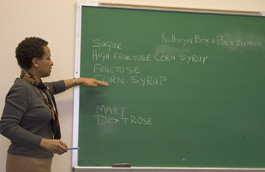
In the early stages of human development, people knew when a berry was poisonous because toxic fruit carry an acrid, bitter taste. These days, tastes can be deceiving. Sugar is considered America’s number one poison.
Kathryn Boyce-Piper RN AADP, a certified nurse who’s suffered from sugar addiction herself, came to BMCC on February 9th to discuss the sociological implications of sugar cravings, as well as the biological breakdown of the sweet stuff in our bodies.
When you bite into a piece of chocolate or a candy bar, it doesn’t take long before a feeling of relaxation kicks in. Why does this happen? Sweets give rise to serotonin levels in the body. Serotonin is the same chemical that promotes relaxation and restful sleep.
Most people find it very confusing to differentiate a good sweet from a bad sweet. It’s not enough to say that honey is better for you than white, granulated sugar. It’s more accurate to say that raw honey is good for you, and processed honey is not, or raw sugar is better for you than white, processed sugar.
Sugar comes from the sugar cane. In it’s purest form—and in reasonable servings–it’s not harmful to the body and even contains vitamins and minerals, which have nutritional value. It’s after the sugar is bleached and stripped of its vitamins and minerals that it’s considered processed. In this state, it has nothing except sweetness and calories.
In trying to break down this “sweet nothing” the body pulls from essential minerals like calcium, causing the body to go into alarm. The pancreas then starts creating insulin, which is especially dangerous for diabetics and can cause weight gain and other physical problems for otherwise-healthy individuals.
In addition to raw and processed sugar, there are also several brands of artificial sweeteners. The sweet flavor of these sugar-substitutes triggers the same response as sugar does in the brain—it begins to produce serotonin, which gives the body an often-deceptive sense of wellness.
Kathryn Boyce-Piper breaks it down in simple terms when she says that the most “body friendly” sugars are the least processed, natural ones. “It all tastes good, and even the good ones are bad when you over-indulge. The body can’t at first distinguish one kind of sweet from another. It’s after the body tries to break it down that we find out the difference.”
It’s not just the taste of sugar that compels people to eat sweets, according to Boyce-Piper. “Sweetness is an experience,” she says. “Sugar can be replaced with more sweetness in one’s life.”
Good Sweets
Maple Syrup: Always opt for Grade B maple syrup. The nutrients aren’t “processed out” so it’s far better for the body than Grade A syrups.
Agave and Agave Syrups: This type of sweetener is a miracle for dieters and diabetics alike. It’s body friendly in that it doesn’t bring up blood-sugar levels.
Raw Sugar and Raw Honey: The word “raw” signifies that these sweeteners are in a purer state because they are not processed.
Brown Rice Syrup: the rice and barley are fermented until the sweetness rises to the top. None of the nutrients are processed “out.”
Fruit-Sugar (Fructose): naturally occurring sugar, often found in fruits and vegetables.
Rapadura: Found in health-food stores, this pure form of sugar is simply cleaned and processed after harvesting. In India, it’s called gur.
Artificial Sweeteners (Aspartame and Sucralose)
Despite advertising claims, sugar substitutes like Equal, NutraSweet and Splendor are even worse than sugar from the sugar cane. What the manufacturers do to simulate the taste of sugar is to remove three of the carbon chains by adding chlorine as one of the ingredients. The result is that the sweetness is comparable to that of real sugar, without the calories, but often with dangerous side effects:
Most Common Side Effects of Prolonged and Excessive Use of Artificial Sweeteners
-Joint pains and stiffness
-Numbness in the limbs (poor circulation)
-Fibromyalgia (fatigue and wide-spread pain)
-Candida (high yeast levels in the body, which cause infections, rashes or other discomforts)

